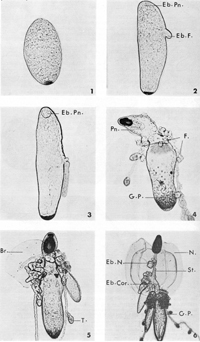
The
development of Nanomia bijuga, a physonect siphonophore (Carré,
1969).

The
life cycle of Muggiaea atlantica, a calycophoran (Carré and
Carré, 1991). The egg
develops into a protozooid that then buds other zooids and grows into
a mature colony.
Eudoxids are shed from the end of the colony. The eudoxids then liberate
egg and sperm, starting the cycle again.
All the zooids in a given siphonophore colony are descended from a single fertilized egg. The egg develops into the protozooid, a polyp that gives rise through budding to all the other zooids of the colony. The very early development of cystonects is completely unknown, but a bit is known about the early stages of development of some physonects and calycophorans.
In the physonects, the protozooid elongates and thins in the center. The pneumatophore forms at the end opposite from the mouth, and the thin part becomes the stem of the colony. Two growth zones form on the young stem. These growth zones are the site of both stem elongation and the origin of new zooids. The growth zone closest to the pneumatophore gives rise to the nectophores, which mature as they are carried down by the growing stem. The other growth zone is just below the oldest nectophore and gives rise to the zooids of the siphosome, which are also carried down as the stem grows.
Calycophorans develop much as physonects do, but with a couple important differences. The end of the protozooid opposite the mouth atrophies, and no pneumatophore forms. The way that calycophoran nectophores arise is not completely understood. In some species new nectophores bud from the base of older nectophores, and in other species they bud directly from the stem. Most calycophorans shed mature cormidia from the end of their stem. Each cormidium, with its single feeding polyp, bract, and reproductive medusa takes up a life free from the rest of the colony. It is not known how long these free cormidia, known as eudoxids, live in the wild. They cannot regenerate into a whole colony, and are restricted to generating only new reproductive medusae.

